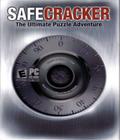Safecracker is a shining example of everything that is wrong with games on the Wii. With the runaway success of the Wii console, many developers have chosen to simply "shovel" cheaply made games onto the Wii or, in other cases, port over an old game to the Wii and attempt to pass it off as something new. Thus, when the topic of the Wii comes up, you often hear the term "shovelware." Safecracker on the Nintendo Wii is a two-and-a-half-year-old PC game that was hastily ported over to the Wii and sold at a budget price. It's not that Safecracker is a bad piece of shovelware; there aren't any gimmicky Wiimote controls, and the core puzzles are actually a lot of fun to figure out. However, to enjoy that, you have to get past the feeling that you're playing a game where virtually every expense was spared.
As with most point-and-click adventure games, Safecracker has you solving puzzles to progress toward an ultimate goal. The usual motivation in these games comes from well-written characters with well-designed dialogue and an interesting story, such as the recent fantastic revival of Sam and Max in episodic form. While Safecracker does a good job with the puzzles presented, there aren't any characters to speak of, the story is paper-thin, the dialogue is virtually nonexistent, and the twist at the end of the story is so laughably bad and predictable that you'll question why you played the game to completion.
In Safecracker, you play a ... safecracker. The premise is that an oil baron, Duncan W. Adams, has gone missing and is presumed dead; the family can't find his will but suspect it's hidden in one of the 30 safes within the home. Apparently, the oil baron was obsessed with safes, so the family calls upon you to find the will. That's the entirety of the story. As you wander around the mansion, you may find occasional letters or diary pages that try to flesh out the inner workings of the family (Everybody wants the rich guy's money! Big surprise!), but these failed to interest me in the meager story. The game may boast six different endings, but all of them are terribly disappointing, as they're simply a black screen with a single line of dialogue on it.
Safecracker is played from a first-person perspective, and you're given free control of your character's head but not his feet. Using pre-rendered environments means that there are only certain places the game will allow you to stand, so moving around the mansion is more like moving from screen to screen, which brings back eerie memories of mid-'90s adventure games such as Myst. There is full camera control, though, so you can look around the full 360 degrees. The game relies on hot spots to move around or interact with the environment, but thankfully, none of the hot spots rely on pixel-hunting to proceed.
To beat Safecracker, all of the approximately 30 safes in the mansion will need to be opened. When you start, you'll only be able to reach one safe, but by solving the puzzles, you'll slowly open up more and more of the mansion to be explored, and therefore find more safes. Many of the safes will contain a hint or vital component needed to open another safe, so there's a certain order to the madness of opening 30 safes. However, with the lengthy load times between each screen, it can be moderately annoying to check each safe and see if the parts and hints you've obtained are pertinent. The biggest offender is the map screen. Pressing the minus button on the Wiimote brings up a map of the house that shows where all of the safes are. Green crosses are safes you've cracked and red ones still need to be opened. This can be useful to figure out where you should head next and I frequently used it, but the load time both in and out of it is much, much longer than it should be, ranging from 15 to 20 seconds.
Safecracker isn't a particularly big game, so you won't find yourself anywhere other than in the two-story mansion. Of course, the pre-rendered environments generally look better than what you see on modern PC and consoles, but much of the environment looks extremely bland and uninteresting; it's often completely static and when it moves, it looks bad. When doors open, artifacting pops up in the shadows, and one instance of water filling a small pool is some of the worst animation I've seen in recent memory.
The audio seems to have had just as little budget thrown at it as the graphics. One song is used during the entire game, and while it's kind of neat to hear the first few times, it quickly starts to grate. It also comes on at the most odd moments, so when it plays seems to have absolutely zero relevance to what's happening in the game at the time. Dialogue consists of a single voice actor occasionally dropping hints about the puzzles or reading the notes that he finds. The work is pretty good, but the writing was a bit baffling. Several times, the actor would talk about the late Duncan W. Adams as though they were best friends, which comes across as extremely bizarre, given the premise of the game.
Neither of these are the focus of the title, however. Safecracker is all about cracking open safes and the pleasure associated with figuring out the puzzle. The vast majority of these puzzles are well done and satisfying when you find the solution. Very few of them are extremely difficult, but most require a burst of clever thinking, and once you figure it out, you'll be smacking your head and wondering why it took you so long to think of it.
Note that I keep saying "puzzles" and not "safes." Not very many of the safes have solutions that make me think, "I just cracked open a safe!. While some safes have keypad locks, some are simply puzzles such as a cipher, routing circuitry or opening a clever lock. Others can be clever with how the number entry needs to be dealt with, the highlight being a safe that responds to the audio of a phone on speaker. Other safes make me feel like I'm reading the Sunday paper. One puzzle is a Sudoku game using currency in a 4x4 grid, another one requires you to win an arcade game to get the contents, and yet another one requires you to place six queens on a chess board in a specific manner. Why anyone would think of those as suitable safes is beyond me, but they make for generally entertaining puzzles.
Once you've finished Safecracker, there is absolutely no reason to play it again. The multiple endings are worthless, and once you know how to solve the puzzles, the magic is gone, so it's no fun to solve something you already know how to solve.
As stated, this is a port of a two-and-a half-year-old PC game, but it becomes more and more obvious as you go that this was a very hasty port. (The Wii's specs are very similar to the minimum requirements for the PC game.) Widescreen support results in the game being stretched, load times are obscenely long for a game that relies on pre-rendered graphics, and what was done specifically for the Wii version was clearly done quickly and cheaply. The single most infuriating bit is how they deal with Wiimote batteries. Once your batteries hit 50 percent charge mark, the game will stop gameplay every 30 seconds to give you the 10-second-long message that you need to change the batteries. At a 50 percent charge, you still have an average of 12 hours of battery life, but eventually, I changed out the batteries just so the game would stop interrupting me twice a minute.
Safecracker for the Wii is a game that suffers from poor production values and limited gameplay. The puzzles are fun the first time around, but the poor porting of the game to the Wii greatly hinders the game, as do the already sub-par production values. If you can get past the nonexistent story, lengthy load times and aggravating audio, there's some good point-and-click puzzle adventuring to be had here. Once all is said and done, though, Safecracker isn't going to be worth most people's time, and the title probably should have stayed on the PC.
Score: 6.0/10
More articles about Safecracker










 You are hired by the wealthy family of a recently deceased billionaire to search for the last will and testament of their late relative. He has hidden the deed to his riches in one of the 35 safes scattered in his magnificent mansion.
You are hired by the wealthy family of a recently deceased billionaire to search for the last will and testament of their late relative. He has hidden the deed to his riches in one of the 35 safes scattered in his magnificent mansion.






























